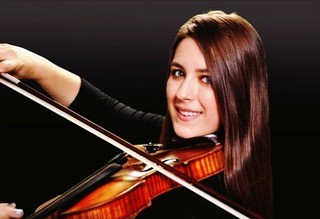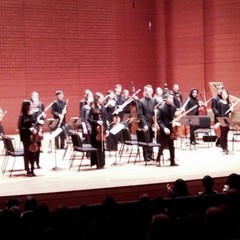|
Back
From Pythagoras To Orpheus To the Gypsy Wedding New York
Alice Tully Hall, Lincoln Center
02/26/2016 -
Igor Stravinsky: Dumbarton Oaks
Josef Haydn: Violin Concerto in C Major, Hob. Vlla:1 – Symphony No. 22 “Philosopher”
Christopher Theofandis: Muse
Zeynep Alpan (Violin)
Juilliard Chamber Orchestra, Eric Bartlett, Eriko Sato (Coaches)

Z. Alpan (© Juilliard School)
Any concert from America’s most estimable conservatory is bound to have a few surprises. Last night’s performance of the Juilliard Chamber Orchestra offered a single jaw-dropping performance, as well as some ultra respectable playing.
The artist in question, Zeynep Alpan, has already had enormous success internationally, but it was a revelation for this first-time listener. In my memory, the young fiddler might have competed with last night’s Baiba Skride who played the first Hungarian offering. But so different were these two artists, from two outlying regions of the musical world (Ms. Skride’s Latvia, Ms. Alpan’s family is Turkish) that similarities would be (in Shakespeare’s words) odorous.
Ms. Skride played a ravishing Bartók, but one had to listen carefully for the elegance and emotional style. Josef Haydn was of course a very different “Hungarian”, living at the Esterházy Palace, but whatever the case Ms. Alpan gave an open arduous performance of Haydn’s Violin Concerto.
Written for his concertmaster-friend Luigi Tomasini (an ancestor of the New York Times reviewer?), it started with difficult double-fingering and continued on that way to the very end, with two difficult cadenzas in the first two movements. Ms. Alpan’s performance started with panache, continuing through this opening movement with strings that were light, sunny and unrelentingly attractive.
The second movement showed her cantabile excellence. But it was the Presto finale where I had an epiphany. Like the other music in this concert, we had a sense of Baroque figuration, but there was more. Haydn must have wanted to escape the stifling atmosphere of the Esterházy Palace, and in that neighborhood of Hungary, he would have either encountered Romany (Gypsy) villages, or he would have heard them play at local celebrations. Would he not have incorporated their melodies into his own youthful concerto? Certainly the way Ms. Alpan performed, one heard more than a piece played in the Palace concert hall: it had all the al fresco joy of a village wedding.

Juilliard Chamber Orchestra (© Samuel A. Dog)
The Juilliard Chamber Orchestra accompanied her well, but the conductor-less group with a fungible membership of 30 is not yet an Orpheus.
At times, as in the rather insipid Stravinsky Dumbarton Oaks concerto, they really did need a conductor. The important horns were faultless, the other winds just as good, but this opener never actually became alive to the composer’s intentions.
Perhaps Ms. Alpan enlivened the ensemble in the second piece, because the third Bach-inspired work, Christopher Theofandis’ Muse was a scintillating study for strings. Originally composed for the Orpheus Chamber Orchestra series, “The New Brandenburgs”, Muse was based on Bach’s Third and had a ravishing texture of strings, played with terrific verve.
Mr. Theofandis ignored Bach’s mathematical lines (as well as his Samos Island ancestor Pythagoras!) for a wall of sounds, which sometimes had the genius of Tippett’s Double String Orchestra; and sometimes (may Mr. Theofandis forgive me), the cascading string feeling of Mantovani. Yet it was always appealing, and did have subtle repeats from a Bach chorale.
The final work was also by Haydn, and the mysterious opening of the 22nd Symphony owed much to Bach’s “walking bass.” That movement gave the appellation “The Philosopher” , though not by the composer. Indeed, when played Adagio, one can picture Pythagoras or Spinoza pacing up and down. The Juilliard Chamber Orchestra didn’t take a chance, though. By playing it Andante, they removed both the imagery and the eeriness.
That problem was alleviated by excellent playing afterwards. Where else does one have two English horns in a single piece of music?? Both Hugo Lee and Russell Hoffman played their parts beautifully. Yet first honors must go to the pair of French horn players, Trevor Nuckols and Kaitlyn Resler, who performed both their duets with the English horns, and the minuet trio with faultless professional skill.
Harry Rolnick
|